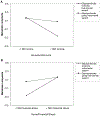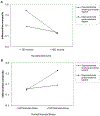The Relationship Between Disproportionate Social Support and Metabolic and Inflammatory Markers: Moderating Role of Socioeconomic Context
- PMID: 33534435
- PMCID: PMC7863584
- DOI: 10.1097/PSY.0000000000000893
The Relationship Between Disproportionate Social Support and Metabolic and Inflammatory Markers: Moderating Role of Socioeconomic Context
Abstract
Objective: The present study examines the association of disproportionate social support (the relative balance of support given versus received) on metabolic and inflammatory outcomes and whether effects vary by socioeconomic context.
Methods: We enrolled a sample of 307 parental caregivers living with a child with a chronic illness. Parents were assessed on four dimensions of social support: emotional support received, instrumental support received, emotional support given, and instrumental support given. Disproportionate social support was calculated as the difference between support received and support given. Participants provided sociodemographic information, were interviewed about financial stress, and were assessed on metabolic (systolic blood pressure, diastolic blood pressure, total cholesterol, body fat percent, and body mass index) and inflammatory (interleukin 6 and C-reactive protein) outcomes.
Results: More disproportionate instrumental and emotional support was associated with higher inflammation (b = 0.10, SE = 0.04, p = .014; b = 0.0.09, SE = 0.05, p = .042, respectively). We observed significant interactions between disproportionate social support and income (b = -0.04, SE = 0.02, p = .021). Parents from lower-income households who gave more emotional support than they received had higher inflammation compared with those from higher-income households. We also observed a significant interaction between disproportionate instrumental support and income (b = 0.04, SE = 0.02, p = .006). Parents from lower-income households who received more instrumental support than they gave had worse metabolic outcomes compared with parents from higher-income households. Parallel interaction patterns were observed using an interview-based measure of financial stress.
Conclusions: These findings show that disproportionate social support has implications for physical health, particularly for caregivers from socioeconomically disadvantaged households.
Copyright © 2020 by the American Psychosomatic Society.
Figures


Similar articles
-
The health and well-being of caregivers of children with cerebral palsy.Pediatrics. 2005 Jun;115(6):e626-36. doi: 10.1542/peds.2004-1689. Pediatrics. 2005. PMID: 15930188
-
Family pediatrics: report of the Task Force on the Family.Pediatrics. 2003 Jun;111(6 Pt 2):1541-71. Pediatrics. 2003. PMID: 12777595
-
The health of primary caregivers of children with cerebral palsy: how does it compare with that of other Canadian caregivers?Pediatrics. 2004 Aug;114(2):e182-91. doi: 10.1542/peds.114.2.e182. Pediatrics. 2004. PMID: 15286255
-
Peer support for disadvantaged parents: a narrative review of strategies used in home visiting health interventions in high-income countries.BMC Health Serv Res. 2020 Jul 23;20(1):682. doi: 10.1186/s12913-020-05540-8. BMC Health Serv Res. 2020. PMID: 32703302 Free PMC article. Review.
-
Community-level interventions for improving access to food in low- and middle-income countries.Cochrane Database Syst Rev. 2020 Aug 5;8(8):CD011504. doi: 10.1002/14651858.CD011504.pub3. Cochrane Database Syst Rev. 2020. PMID: 32761615 Free PMC article.
Cited by
-
Reflections on resilience.Dev Psychopathol. 2024 Dec;36(5):2551-2558. doi: 10.1017/S0954579424000403. Epub 2024 Feb 23. Dev Psychopathol. 2024. PMID: 38389301 Free PMC article.
-
Factors associated with peritraumatic stress symptoms among the frontline healthcare workers during the outbreak of COVID-19 in China.BMJ Open. 2022 Jan 11;12(1):e047753. doi: 10.1136/bmjopen-2020-047753. BMJ Open. 2022. PMID: 35017231 Free PMC article.
-
Association between drinking water quality and mental health and the modifying role of diet: a prospective cohort study.BMC Med. 2024 Feb 2;22(1):53. doi: 10.1186/s12916-024-03269-3. BMC Med. 2024. PMID: 38302940 Free PMC article.
-
The balance of giving versus receiving social support and all-cause mortality in a US national sample.Proc Natl Acad Sci U S A. 2021 Jun 15;118(24):e2024770118. doi: 10.1073/pnas.2024770118. Proc Natl Acad Sci U S A. 2021. PMID: 34099550 Free PMC article.
References
-
- House JS, Landis KR, & Umberson D Social relationships and health. Science 1988;24:540–45. - PubMed
-
- Holt-Lunstad J, & Uchino BN Social support and health. Health behavior: Theory, research and practice 2015;183–204.
-
- Barth J, Schneider S, von Kanel R. Lack of social support in the etiology and the prognosis of coronary heart disease: A systematic review and meta-analysis. Psychosom Med 2010;72:229–38 - PubMed
-
- Lutgendorf SK, Sood AK, Anderson B, McGinn S, Maiseri H, Dao M, Sorosky JI, de Geest K, Ritchie J, Lubaroff DM. Social support, psychological distress, and natural killer cell activity in ovarian cancer. J Cardiovasc Nurs 2005;20(3):162–69. - PubMed
Publication types
MeSH terms
Grants and funding
LinkOut - more resources
Full Text Sources
Medical
Research Materials

